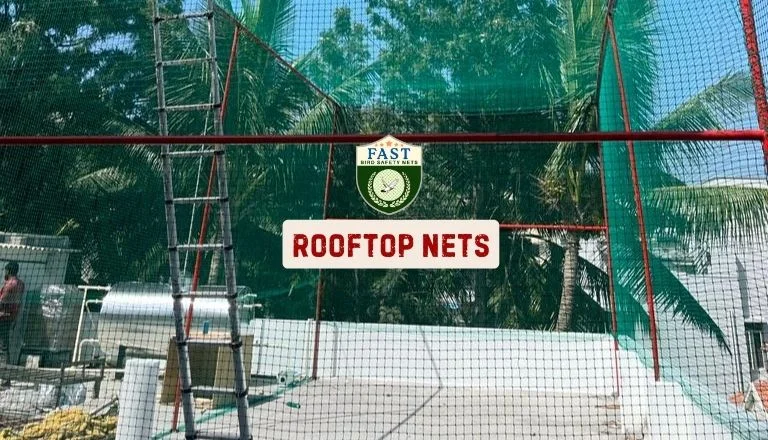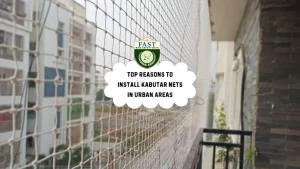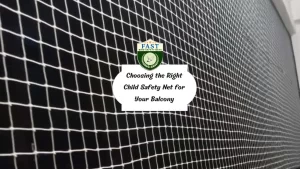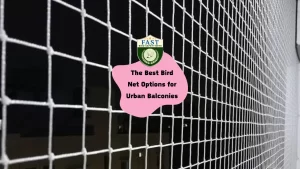Birds are beautiful creatures that bring life and vitality to our surroundings. However, when it comes to our properties, they can sometimes pose a significant challenge. Birds nesting or roosting on rooftops can create various problems, from structural damage to health hazards. As property owners, it’s essential to take proactive measures to prevent these issues. One effective solution gaining popularity is the use of rooftop nets, particularly fast safety nets, which offer numerous advantages in bird prevention and property protection.

Understanding the Bird Problem
Before delving into the importance of rooftop nets, it’s crucial to understand the scope of the bird problem. Birds, especially pigeons and seagulls, often seek out high places like rooftops for nesting and roosting. While this behavior might seem harmless at first, it can lead to several issues:
Structural Damage: Bird droppings contain acidic compounds that can corrode roofing materials, leading to deterioration and leaks. Additionally, nests built in gutters or vents can block drainage systems, causing water damage.
Health Hazards: Bird droppings carry numerous pathogens and parasites, posing health risks to humans. Exposure to bird droppings can cause respiratory issues, fungal infections, and even diseases like histoplasmosis and cryptococcosis.
Aesthetic Concerns: Accumulated bird droppings not only make a property look unsightly but also emit foul odors. This can deter customers, tenants, or visitors and harm the reputation of businesses or residences.
Safety Risks: Bird droppings are slippery when wet, increasing the risk of slips and falls on walkways and entry points. Moreover, nesting materials can clog machinery or equipment on rooftops, potentially causing malfunctions or accidents.
The Role of Rooftop Nets in Bird Prevention
Traditional methods of bird control, such as spikes, wires, or repellents, often provide temporary solutions and may not address the problem comprehensively. Rooftop nets, especially fast safety nets, offer a more holistic approach to bird prevention with several key benefits:
Effective Barrier: Fast safety nets create a physical barrier that prevents birds from accessing rooftops and other elevated areas. Made from durable materials like high-density polyethylene (HDPE) or nylon, these nets are designed to withstand harsh weather conditions and bird activity.
Humane Solution: Unlike some bird control methods that may harm or injure birds, rooftop nets offer a humane way to deter them without causing harm. Birds are simply unable to land or nest on the protected area, encouraging them to seek alternative roosting sites.
Versatility: Fast safety nets are highly versatile and can be customized to fit various roof shapes and sizes. They can also be installed on different types of structures, including commercial buildings, warehouses, bridges, and residential properties.
Low Maintenance: Once installed, rooftop nets require minimal maintenance compared to other bird control measures. Routine inspections may be necessary to ensure the nets remain intact and free from debris, but overall upkeep is relatively simple.
Long-Term Solution: By addressing the root cause of the problem – birds accessing rooftops – rooftop nets provide a long-term solution to bird infestations. This can save property owners time and money that would otherwise be spent on recurring pest control treatments or repairs.
Aesthetically Pleasing: Unlike unsightly deterrents like spikes or wires, rooftop nets are discreet and blend seamlessly with the architecture of the building. They do not detract from the visual appeal of the property and may even enhance its overall appearance.
Installation and Maintenance Guidelines
While rooftop nets offer numerous benefits, proper installation and maintenance are critical to their effectiveness. Here are some guidelines to ensure optimal performance:
Professional Installation: It’s essential to hire experienced professionals who specialize in bird control to install rooftop nets. They have the expertise and equipment necessary to ensure the nets are installed correctly and securely.
Regular Inspections: Schedule regular inspections of the rooftop nets to check for any signs of damage or wear. Replace damaged or compromised sections promptly to maintain the integrity of the barrier.
Keep Surrounding Areas Clean: To deter birds from lingering near the property, keep surrounding areas clean and free from food sources or standing water. This includes proper garbage disposal, minimizing outdoor dining areas, and repairing any leaks or drainage issues.
Educate Tenants or Residents: If the property is multi-tenant or residential, educate occupants about the purpose of the rooftop nets and the importance of maintaining a bird-free environment. Encourage cooperation in adhering to guidelines for waste disposal and cleanliness.
Monitor Bird Activity: Keep an eye on bird activity around the property, especially during nesting seasons. Early detection of potential roosting sites or nesting attempts can help prevent infestations before they become problematic.
Address Potential Entry Points: In addition to rooftop nets, identify and seal off any other potential entry points birds may use to access the property. This could include gaps in building structures, vents, or openings in eaves and facades.
Conclusion
Protecting your property from the adverse effects of bird infestations is essential for maintaining its integrity, safety, and aesthetic appeal. Rooftop nets, particularly fast safety nets, offer a comprehensive solution to bird prevention by creating an effective barrier that deters birds without causing harm. By investing in rooftop nets and following proper installation and maintenance guidelines, property owners can enjoy long-term protection and peace of mind.
Incorporating rooftop nets into your bird control strategy demonstrates a commitment to sustainability, safety, and responsible property management. With the right approach and support from professionals, you can effectively mitigate the risks associated with bird infestations and safeguard your property for years to come.






